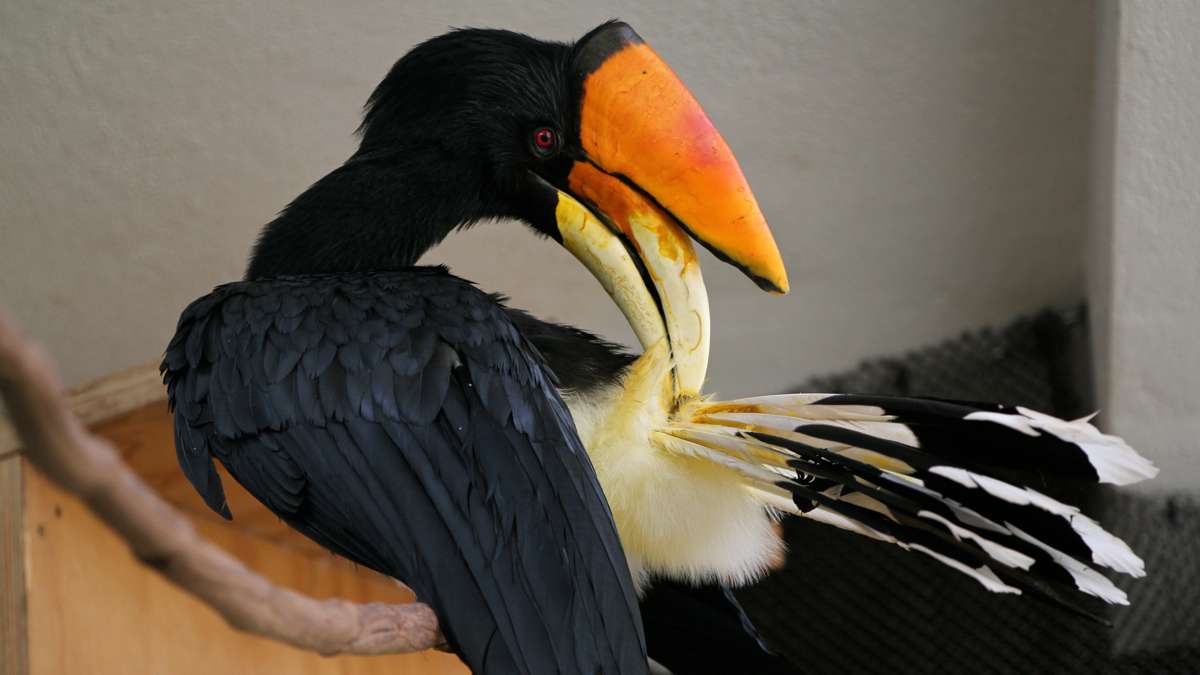In quest for fidelity, a model from the animal kingdom
ListenHornbill birds, native to Africa and Asia, come in dozens of different species. Some, like the striking rhinoceros hornbill, have a bony casque or protrusion on top of a bright, Toucan-like beak. India’s Malabar grey hornbill, with a more subtly colored beak, is a smaller, less flashy relative.
Nearly all hornbills, however, have one thing in common: when the female hornbill is ready to lay her eggs, she enters her nest in a tree hole and seals herself in, not to emerge until after her chicks are hatched.
The female rhinoceros hornbill stays in those cramped quarters for about a month and a half. Other species stay in longer. The male, meanwhile, makes dozens of food deliveries per day through a tiny, beak-sized hole in the nest wall.
In many species, the female molts her wing and tail feathers all at once during this sequestration, leaving her completely dependent on her mate.
“If something happens to him, she’s out of luck, too, because she no longer has her flight feathers,” said Aliza Baltz, curator of birds at the Philadelphia Zoo, where a pair of rhinoceros hornbills is in residence. “If she comes out of the nest, she’s pretty vulnerable, she can’t really fly away from predators and it’s difficult for her to, you know, access food.”
Fear of infidelity or predators?
Is this a sign of ultimate paternal devotion in the animal kingdom, or of an overly jealous husband?
Early biologists thought the motivation was jealousy.
In 1863, famed British naturalist Alfred Russel Wallace wrote in a journal article that the male hornbill ‘imprisoned’ the female in a kind of tower of purity. Natives in Java, he wrote, “assert that if any traces appear of the nest having been visited during the absence of the male bird he will on his return completely close up the opening with mud, and leave his unhappy wife and children to perish.”
By the twentieth century, scientists had their facts more in order. A 1935 paper by R.E. Moreau noted, correctly, that it is actually the female who builds most of the nest seal, and she is not “in any way compelled by the male to shut herself in.”
Still, the question of why hornbills seal their nests continues to nag researchers.
‘Lovebirds’ rarer than once thought
While most birds have long been observed to be monogamous, recent DNA testing of chicks has proven otherwise, said Mark Stanback, a biologist at Davidson College in North Carolina.
“Researchers have realized that even though the vast majority of birds are socially monogamous, not all birds are genetically monogamous,” Stanback said. “Meaning that, we now know that in most cases, female birds are happy to cheat on their spouses and copulate with other males to get higher quality genes for their offspring.”
Because a female hornbill can store sperm in her body for up to a month, she could still cheat on her mate despite the nest seal.
So Stanback developed a theory: the sealed nest is not so much a chastity belt, he reasoned, as an implicit threat for the female from the male. If the male suspected any chicks in his nest weren’t his, he could – as the female would know — feed the brood less or none at all, leaving all to starve.
However, while researching hornbills in Namibia, Stanback quickly realized females in many species would never have evolved to molt their flight feathers if there were a chance they would be abandoned.
Now, he believes nest-sealing is not a way to keep the females in, but a way to keep everyone else out.
“The sealing of the female into the nest I think is predator-driven,” Stanback said. “By having this closed-up hole with just a small gap in it, it makes the female and the eggs and chicks much safer from predators.”
That is the predominant theory in the literature, and the one Philadelphia Zoo bird curator Aliza Baltz ascribes to, but there is at least one other.
Female in charge
Margaret Kinnaird, author of the 2007 book, “The Ecology and Conservation of Asian Hornbills,” started her hornbill research with the same predator theory as Stanback.
“But where I studied, there were very, very few predators,” Kinnaird said. “So we started thinking about different things it might be.”
Kinnaird, now the executive director of the Mpala Research Centre in northern Kenya, turned the tables on the traditional fidelity hypothesis.
Maybe the seal is actually the female’s way to keep the male faithful.
“If the female seals herself in and the male has to provide all of the food for both himself, and her, and her growing chicks, he’s not going to have time to provision another nest,” Kinnaird said.
Because feeding his mate and chicks is a full-time job, if he steps away from that to engage with another female, “he’s going to lose his entire reproductive investment,” Kinnaird said.
“She has said, ‘Hey man, deliver me the bonbons, because I’m sitting in here all closed up,'” Kinnaird said.
Kinnaird’s theory has been criticized for downplaying the predator factor, but she stands behind it.
“When you read some of the literature, mainly the popular literature, the old literature, (it says) ‘Oh, the male hornbill does the equivalent of putting a chastity belt on the female hornbill,'” Kinniard said. “How is what I’m saying any more extreme? It’s just what we’re used to hearing, the male is always in control.”
However this nest-sealing behavior developed, hornbills have evolved into an unusually monogamous species.
While researching in Namibia in the mid-1990s, Mark Stanback tested the paternity of 135 hornbill chicks and found every one of them had the DNA of its presumed father, the mate of its mother.
“In many ways because we now recognize that conflict is such a big part of animal behavior and the battle of the sexes, we sometimes overlook the importance of cooperation in enhancing individual organisms’ personal fitness,” Stanback said.
In non-scientific terms, that means in the animal kingdom, sometimes faithfulness does pay off.
WHYY is your source for fact-based, in-depth journalism and information. As a nonprofit organization, we rely on financial support from readers like you. Please give today.














